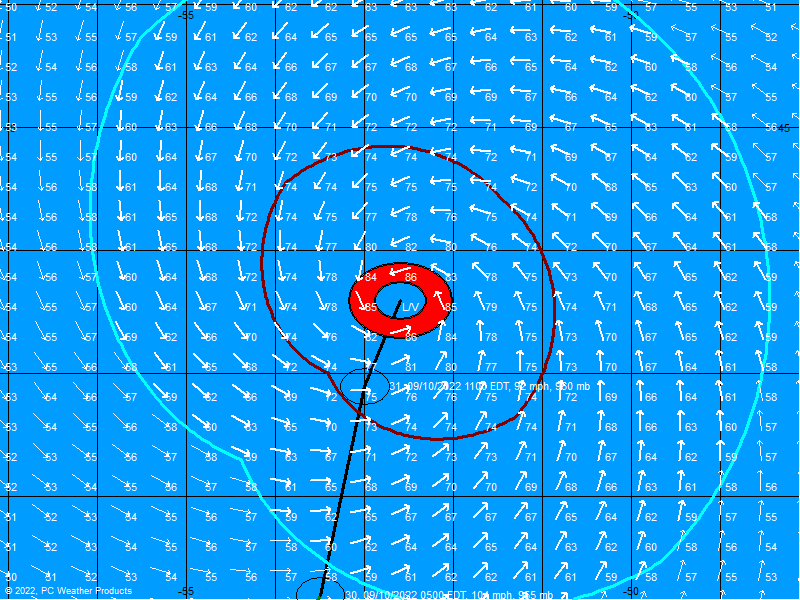TS Ernesto Satellite,Analysis and Models Thread #5
Moderator: S2k Moderators
Forum rules
The posts in this forum are NOT official forecasts and should not be used as such. They are just the opinion of the poster and may or may not be backed by sound meteorological data. They are NOT endorsed by any professional institution or STORM2K. For official information, please refer to products from the National Hurricane Center and National Weather Service.
tgenius wrote:T3.0? sure that was for this system, lol? That's VERY high.
Yes
http://www.meteo.psu.edu/~gadomski/tropclass.txt
0 likes
-
Jim Cantore
-
Wx_Warrior
- Category 5

- Posts: 2718
- Joined: Thu Aug 03, 2006 3:58 pm
- Location: Beaumont, TX
-
jaxfladude
- Category 5

- Posts: 1249
- Joined: Wed Aug 24, 2005 9:36 pm
- Location: Jacksonville, Fla
-
miamicanes177
- Category 5

- Posts: 1131
- Joined: Tue Aug 01, 2006 10:53 pm
Tropical Storm Ernesto Discussion Number 18
Statement as of 11:00 PM EDT on August 28, 2006
Air Force reconnaissance data through 00z showed that the center of
Ernesto was still inland. Highest winds from the flight just
offshore were 46 kt about 6 hours ago...and more recently 37 kt.
Based on these data...Ernesto will be held at minimal tropical
storm strength. The reconnaissance data showed that the center was
inland...and since that time...Cuban radar and surface observations
from Camaguay indicate that the center remains inland. The radar
data show a gradual deterioration in the organization of
Ernesto...and satellite imagery shows only very limited deep
convection with the system. The upper-level low near Andros appears
to be advecting dry air into the cyclone...which may account for
the anemic convection. This low is forecast to move out and weaken
over the next 24 hours...leaving Ernesto under light easterly
shear. This would favor gradual intensification after the center
clears the coasts...but the upper winds would not seem to favor
rapid development. The official intensity forecast is a blend of
the SHIPS and GFDL guidance...and represents a downward adjustment
from the previous package. Although there is still some chance that
Ernesto could become a hurricane before reaching Florida...the
liklihood of this is diminishing.
The initial motion is 300/10. Ernesto has been moving to the left
of the previous forecast...and this requires a slight westward
shift of the forecast track. Model guidance continues to
aggressively move the mid-level high pressure offshore the
southeastern United States to allow Ernesto to turn northwestward.
Dropsonde and raob data from 00z indicate that the ridge axis is
still at 80-81w...still ahead of the cyclone's longitude. This
could mean that some slight westward track adjustments are in the
offing.
Forecast positions and Max winds
initial 29/0300z 21.7n 77.8w 35 kt
12hr VT 29/1200z 23.0n 79.1w 40 kt
24hr VT 30/0000z 24.6n 80.3w 55 kt
36hr VT 30/1200z 26.4n 80.9w 50 kt...inland
48hr VT 31/0000z 28.5n 81.0w 45 kt...inland
72hr VT 01/0000z 33.0n 80.0w 60 kt...inland
96hr VT 02/0000z 36.5n 78.5w 25 kt...remnant low
120hr VT 03/0000z 39.0n 77.5w 20 kt...extratropical
$$
forecaster Franklin
Statement as of 11:00 PM EDT on August 28, 2006
Air Force reconnaissance data through 00z showed that the center of
Ernesto was still inland. Highest winds from the flight just
offshore were 46 kt about 6 hours ago...and more recently 37 kt.
Based on these data...Ernesto will be held at minimal tropical
storm strength. The reconnaissance data showed that the center was
inland...and since that time...Cuban radar and surface observations
from Camaguay indicate that the center remains inland. The radar
data show a gradual deterioration in the organization of
Ernesto...and satellite imagery shows only very limited deep
convection with the system. The upper-level low near Andros appears
to be advecting dry air into the cyclone...which may account for
the anemic convection. This low is forecast to move out and weaken
over the next 24 hours...leaving Ernesto under light easterly
shear. This would favor gradual intensification after the center
clears the coasts...but the upper winds would not seem to favor
rapid development. The official intensity forecast is a blend of
the SHIPS and GFDL guidance...and represents a downward adjustment
from the previous package. Although there is still some chance that
Ernesto could become a hurricane before reaching Florida...the
liklihood of this is diminishing.
The initial motion is 300/10. Ernesto has been moving to the left
of the previous forecast...and this requires a slight westward
shift of the forecast track. Model guidance continues to
aggressively move the mid-level high pressure offshore the
southeastern United States to allow Ernesto to turn northwestward.
Dropsonde and raob data from 00z indicate that the ridge axis is
still at 80-81w...still ahead of the cyclone's longitude. This
could mean that some slight westward track adjustments are in the
offing.
Forecast positions and Max winds
initial 29/0300z 21.7n 77.8w 35 kt
12hr VT 29/1200z 23.0n 79.1w 40 kt
24hr VT 30/0000z 24.6n 80.3w 55 kt
36hr VT 30/1200z 26.4n 80.9w 50 kt...inland
48hr VT 31/0000z 28.5n 81.0w 45 kt...inland
72hr VT 01/0000z 33.0n 80.0w 60 kt...inland
96hr VT 02/0000z 36.5n 78.5w 25 kt...remnant low
120hr VT 03/0000z 39.0n 77.5w 20 kt...extratropical
$$
forecaster Franklin
0 likes
-
Scorpion
-
Wx_Warrior
- Category 5

- Posts: 2718
- Joined: Thu Aug 03, 2006 3:58 pm
- Location: Beaumont, TX
Who is online
Users browsing this forum: No registered users and 83 guests






